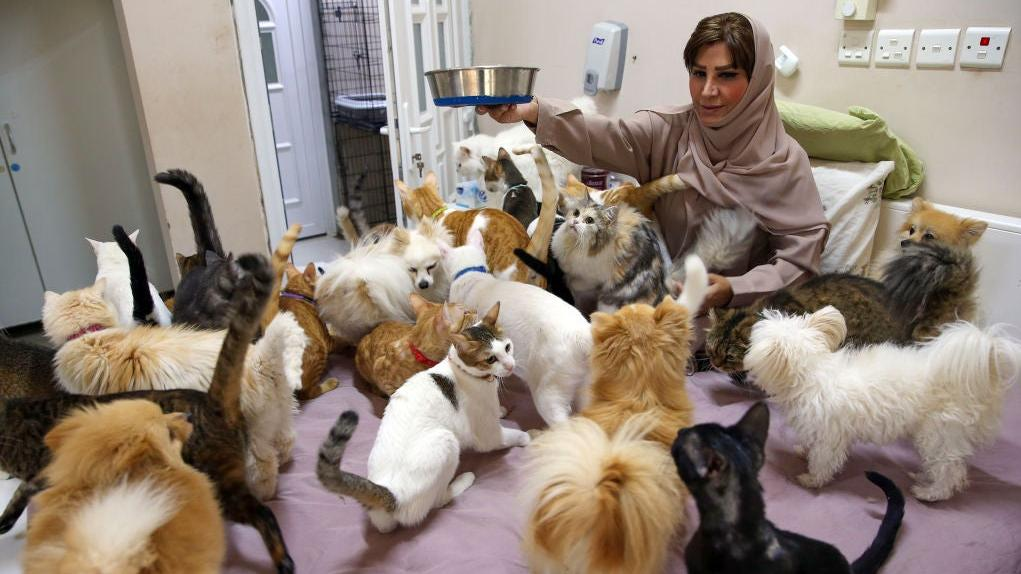The Real Reason Your Pets Are So Addicted To Their Store-Bought Food
Humans love processed food. Scientists tinker with it so it tastes good with the optimal mix of sweet and salty, and once you get a bite of some, it can be hard to resist (like me and a hot pile of McDonald's fries). It's the same for our animal companions. The BBC recently took a deep dive into the contents of our furry friend's kibble bowls to find out just what's going on in there that gets them worked up into such a frenzy around dinnertime.
"Big [pet food] companies have huge departments that make palatants," or ingredients that make us want to eat things, said Darren Logan, head of research at the Waltham Petcare Science Institute, which is part of the company Mars Petcare. "Just like we make them for humans, we make them for pets as well."
Here's a fun tidbit: The first pet food invented was by James Spratt in 1860. He was a lightning rod salesman from Ohio. The story has it that he was in Liverpool, England, for business, and saw stray dogs on the docks eating leftover hardtack biscuits. This was notable for multiple reasons.
First, even then, hardtack had a reputation for being gross. People called it "sheet iron" and "worm castle," which make it sound absolutely delicious. (The "worm castle" nickname came from the fact that hardtack frequently became infested with maggots and weevils, which sounds like the definition of a good time to me.)
Also, at that point, nobody had really thought that pet food was something that you could sell for profit. Pets would either eat scraps from what the humans were eating, or they'd just fend for themselves. So Spratt decided to make food dedicated for dogs. He developed a recipe for something called the "Meat Fibrine Dog Cake," which probably was as scrumptious as it sounded—it was made of beets, vegetables, grains, and mysteriously sourced beef (it apparently was so mysterious he took the secret all the way to his grave).
The Meat Fibrine Dog Cakes were marketed as a luxury item for pets owned by the wealthy. At the time, people were starting to consider their pets part of the family instead of workers or street urchins, so those who could afford it decided they deserved better than scraps from the alley. Advertisements labeled the Meat Fibrine Dog Cakes "Dog's Delight." Eventually, the sentiment expanded to cats, and they got their own special food, too.
Now you can buy food for nearly any kind of pet. Most of this food follows the same basic formula: some base carbohydrate, proteins, fat, sugar, fiber, antioxidants and additional preservatives, emulsifiers, vitamins, and coloring agents. The fancy stuff can also contain probiotics, enzymes, anti-parasitic compounds, and minerals for oral health. All this is combined into a paste and extruded through a plate with holes in it and then baked into kibbles.
"From my standpoint as a nutritionist, all pet foods are the same," Marion Nestle, professor emerita of nutrition, food studies, and public health at New York University, told the BBC.
So this is why processed pet food manufacturers rely on chemistry to appeal to our pets' sense of smell. The extra flavors are sprayed on or added on at the end as a powder, just like in human snack foods. Smell is the sense most animals use to navigate the world around them, so that's what pet food developers try to appeal to. The big catch is that cats and dogs like the smell of things that most people... don't. Like rotting flesh, for example. Or feces.
So pet food manufacturers have made a point of including offal extracts and lab-made ingredients like putrescine and cadaverine (two great names). So the smell of pet food is really what drives your cats and dogs crazy, not necessarily the taste.
There's plenty more fascinating, in-depth info in the article, so if you're looking for an educational Friday distraction, definitely give the piece a read. But do it after you feed your little buddies.
